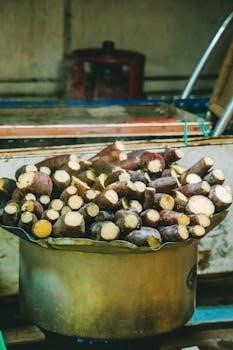What is Resistant Starch?
Resistant starch is a type of carbohydrate that resists digestion in the small intestine. It ferments in the large intestine, feeding beneficial gut bacteria; This process produces short-chain fatty acids, offering various health benefits.
Definition of Resistant Starch
Resistant starch, a unique form of dietary fiber, is defined as the total starch and its degradation products that resist digestion in the small intestine. Unlike typical starches that break down into glucose, resistant starch passes through the small intestine undigested. This undigested starch then enters the colon, where it undergoes fermentation by the gut microbiota. This fermentation process leads to the production of beneficial short-chain fatty acids. The resistant nature of this starch means it doesn’t contribute to rapid blood sugar spikes like other carbohydrates. Instead, it acts as a prebiotic, nourishing the good bacteria in the gut and promoting a healthy microbiome balance. This makes it a valuable component of a healthy diet with potential benefits for digestion and overall well-being.

Types of Resistant Starch
Resistant starch is categorized into four main types, each with distinct characteristics. These types are based on their source, structure, and how they are processed.
Type 1 Resistant Starch
Type 1 resistant starch is found in foods like partially milled grains and seeds. This type of starch is physically inaccessible to digestive enzymes because it is trapped within the plant’s cell walls. The fibrous structure of these foods protects the starch from being broken down in the small intestine. Grinding or milling these foods can make the starch more accessible, reducing the resistant starch content. Examples include whole grains, some legumes, and dense starchy foods where the starch granules are embedded within the cellular matrix, and it requires processing like milling to release it. Type 1 resistant starch is a natural form of resistant starch, and its presence depends on the plant’s structure.
Type 2 Resistant Starch
Type 2 resistant starch is characterized by its unique granular structure that makes it difficult for digestive enzymes to access and break down. This form of resistant starch is commonly found in raw starchy foods such as unripe green bananas and raw potatoes. The starch granules in these foods are tightly packed, creating a compact structure that resists enzymatic digestion in the small intestine. The compact nature of Type 2 resistant starch prevents it from being easily metabolized by the body. As a result, it passes through to the large intestine, where it is fermented by the gut microbiota, contributing to the production of beneficial compounds. Cooking these foods will generally change the starch structure and reduce resistant starch content.
Type 3 Resistant Starch
Type 3 resistant starch, also known as retrograded starch, is formed when starchy foods are cooked and then cooled. This process alters the molecular structure of the starch, causing some of it to become resistant to digestion. Examples include cooked and cooled potatoes, rice, and pasta. The heating gelatinizes the starch, making it digestible; however, upon cooling, some of the starch molecules realign, forming a crystalline structure that digestive enzymes cannot easily break down. This process increases the resistant starch content of these foods, making them beneficial for gut health. The amount of retrogradation, and therefore the resistant starch content, can vary depending on cooking method and cooling time. This type of resistant starch is a good option to incorporate into your diet.
Type 4 Resistant Starch
Type 4 resistant starch is a chemically modified form of starch created through industrial processes. Unlike the naturally occurring types, it does not form through cooking or cooling but is specifically engineered to resist digestion. These modifications are usually performed to create resistant starch, which can be incorporated into processed foods such as breads, cakes, and other baked goods. The chemical modifications alter the structure of the starch, making it difficult for digestive enzymes to break it down. This type of resistant starch aims to add the health benefits of resistant starch to processed foods without the need for cooking or cooling. While it is not naturally found in whole foods, it is increasingly used in the food industry to enhance the nutritional profile of various products.

Health Benefits of Resistant Starch
Resistant starch offers numerous health advantages, including improved gut health, enhanced insulin sensitivity, and support for weight management. These benefits stem from its unique ability to ferment in the colon.
Gut Health Improvements
Resistant starch plays a vital role in promoting a healthy gut. Unlike regular starches that are digested and absorbed in the small intestine, resistant starch travels to the colon where it is fermented by the gut microbiota. This fermentation process produces short-chain fatty acids (SCFAs), such as butyrate, which are crucial for maintaining the integrity of the gut lining and reducing inflammation. Butyrate, in particular, has been shown to have anti-inflammatory effects and can help protect against conditions like colon cancer. By nourishing beneficial bacteria, resistant starch contributes to a balanced gut microbiome, which is essential for overall health. Additionally, it can help ease constipation by promoting regular bowel movements and increasing stool bulk. The fermentation of resistant starch also leads to a healthier gut environment, reducing the risk of various digestive issues.
Improved Insulin Sensitivity
Resistant starch has a notable impact on improving insulin sensitivity, which is the body’s ability to effectively use insulin to regulate blood sugar levels; When we consume resistant starch, it bypasses digestion in the small intestine, reducing the rapid release of glucose into the bloodstream. This, in turn, decreases the demand for insulin, potentially leading to better blood sugar control over time. Studies suggest that regular consumption of resistant starch can enhance the body’s response to insulin, which can be particularly beneficial for individuals with insulin resistance or at risk of developing type 2 diabetes. By improving insulin sensitivity, resistant starch may also help reduce the risk of conditions like heart disease and Alzheimer’s disease, which are often linked to impaired insulin function. Furthermore, a diet rich in resistant starch may help stabilize blood sugar levels, promoting better metabolic health.
Weight Management
Resistant starch plays a significant role in weight management due to several factors. Firstly, it has fewer calories per gram compared to regular starches, containing only 2.5 calories versus 4 calories. Secondly, resistant starch is not easily digested, meaning the body expends more energy trying to break it down. This increased energy expenditure can contribute to weight loss or maintenance. Additionally, resistant starch promotes feelings of fullness and satiety, helping to control appetite and reduce overall food intake. By slowing down digestion, it also helps prevent rapid spikes in blood sugar, which can often lead to cravings and overeating. Furthermore, the fermentation of resistant starch in the large intestine produces short-chain fatty acids, which can influence metabolism and fat storage. Therefore, incorporating resistant starch into your diet can be a valuable strategy for achieving and maintaining a healthy weight.

Foods High in Resistant Starch
Foods rich in resistant starch include oats, rice, green bananas, beans, legumes, and cooked then cooled potatoes. These foods offer various types of resistant starch, contributing to health benefits.
Naturally Occurring Sources
Many whole foods naturally contain resistant starch, offering a variety of options to incorporate into your diet. Unripe bananas, particularly green ones, are a notable source of type 2 resistant starch, which is difficult for digestive enzymes to break down. Legumes like beans and lentils are also rich in resistant starch, providing both fiber and nutritional value. Whole grains such as oats, barley, and some varieties of corn contain type 1 and type 3 resistant starches, depending on processing. These starches are found within the cell walls or formed during cooling. Additionally, raw potatoes contain type 2 resistant starch. These naturally occurring sources offer a good base for increasing resistant starch intake through whole food options. It is important to note that processing methods affect the resistant starch levels of these foods.
Modified Starch Sources
Modified starch sources are created through specific processing techniques to enhance the amount of resistant starch. Type 4 resistant starches are often chemically modified and found in certain processed foods, including some types of bread and cakes. High amylose varieties of corn, wheat, barley, potato, and rice have been specifically bred to increase their resistant starch content. These modified starches are designed to survive baking and extrusion processes, making them suitable for use in processed food products. Some flours, such as green banana flour, plantain flour, cassava flour, and potato starch, contain high levels of resistant starch when raw but lose this property when cooked. These modified starch sources offer an alternative for incorporating resistant starch into processed food products and recipes, but the resistant starch content can vary depending on the processing methods used.

Preparation Methods for Resistant Starch
Cooking and cooling starches, like potatoes, rice, and pasta, increases their resistant starch content. This process, known as retrogradation, transforms some digestible starch into resistant starch.
Cooking and Cooling Starches
The process of cooking and then cooling certain starchy foods is a key method to enhance their resistant starch content. When foods like potatoes, rice, and pasta are cooked, their starch granules absorb water and swell. Upon cooling, a portion of this starch undergoes a process called retrogradation. During retrogradation, the starch molecules reorganize themselves, forming a structure that is more resistant to digestion in the small intestine. This transformation increases the amount of resistant starch present in the food. It’s important to note that the degree of retrogradation and the resulting increase in resistant starch can vary depending on the specific food, the cooking method, and the cooling time.
